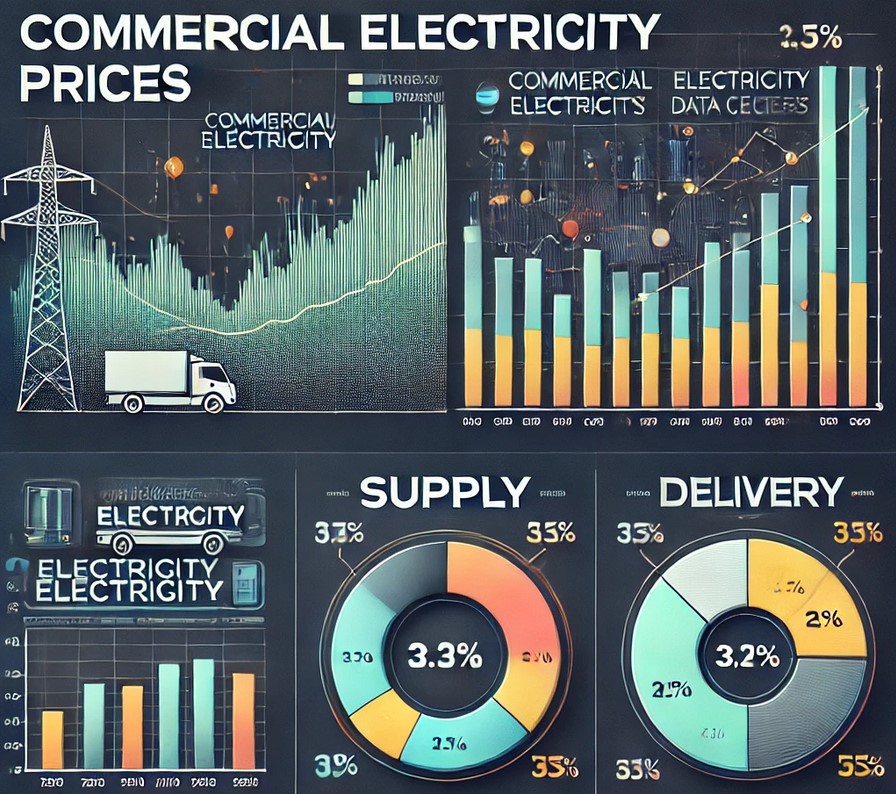Fixed All-In Rates, Capacity Pass-Through, and Bilateral Capacity Adjustment

Detailed Comparison of Fixed All-In Rates, Capacity Pass-Through, and Bilateral Capacity Adjustment
When selecting an electricity pricing model, businesses typically have three primary options: Fixed All-In Rates, Capacity Pass-Through, and Bilateral Capacity Adjustment. Each of these models offers different approaches to handling energy and capacity costs, which are crucial components of electricity pricing. Let’s take a deeper dive into the details and differences of these models.
1. Fixed All-In Rates
Overview
A Fixed All-In Rate bundles all electricity cost components—energy supply, capacity charges, transmission fees, and other associated costs—into one fixed rate per kilowatt-hour (kWh). This rate remains constant throughout the duration of the contract, regardless of changes in market conditions.
Key Features
- Single Fixed Price: Energy, capacity, and other charges are included in a single rate, providing stability.
- No Market Risk: Customers are protected from fluctuations in energy prices, capacity charges, and demand-related costs.
- Simple and Predictable: This model simplifies budgeting since the price remains constant throughout the contract term.
Benefits
- Budget Certainty: Businesses can plan their energy costs without the risk of price volatility.
- Low Risk: Since all costs are bundled into a single rate, there is no exposure to market-driven price changes or unexpected capacity charges.
- Ease of Management: There’s no need to track market trends or renegotiate pricing; all costs are locked in.
Drawbacks
- No Flexibility: Businesses cannot benefit from falling energy or capacity prices during the contract term.
- Potentially Higher Costs: Fixed rates often include a premium to cover the supplier’s risk, meaning businesses may pay more than the market price during periods of low demand.
Best For
- Businesses that value stability and predictability in their energy bills.
- Companies with limited resources to monitor and manage energy market trends.
2. Capacity Pass-Through
Overview
In a Capacity Pass-Through pricing model, the energy supplier separates the capacity charges from the energy supply costs. The capacity charge, which is the cost of ensuring there is enough electricity generation to meet peak demand, is passed directly to the customer based on real-time market prices and actual usage.
Key Features
- Direct Market Exposure: The capacity charge is not fixed and fluctuates based on market conditions.
- Variable Costs: Energy supply rates may remain fixed, but capacity charges vary depending on the business's share of peak demand and current market prices.
- Risk of Price Spikes: Capacity charges tend to increase during peak demand periods or when the market is under stress (e.g., during a heatwave or cold snap).
Benefits
- Potential Cost Savings: Businesses that can reduce usage during peak demand periods or shift usage to off-peak times may benefit from lower capacity charges.
- Transparency: Companies see exactly how much they are paying for capacity, based on their contribution to system-wide peak demand.
- No Capacity Premium: Unlike a fixed all-in rate, there is no built-in premium to hedge against capacity cost risk.
Drawbacks
- Higher Risk: Capacity charges can spike during high-demand periods, leading to significant cost variability.
- Requires Active Management: Businesses must actively manage their energy use, particularly during peak times, to minimize their exposure to high capacity costs.
Best For
- Businesses with flexibility in energy usage patterns or those that can shift usage to off-peak times.
- Companies with energy expertise that can monitor market trends and respond to changing conditions.
3. Bilateral Capacity Adjustment
Overview
A Bilateral Capacity Adjustment is a contract between a business and a supplier where the capacity charge is negotiated separately from the energy supply rate. Unlike Capacity Pass-Through, where the capacity charge is entirely dictated by the market, a Bilateral Capacity Adjustment involves setting terms that allow for a more customized approach to capacity pricing.
Key Features
- Negotiated Terms: Capacity prices are negotiated between the buyer and supplier, allowing for tailored contract terms based on the business's energy load and demand profile.
- Some Flexibility: Capacity costs may still adjust over time, but businesses have more control over these adjustments through negotiation.
- Long-Term Planning: This model allows businesses to plan for capacity costs while still benefiting from some flexibility based on market conditions.
Benefits
- Tailored Pricing: Businesses can negotiate favorable terms, often resulting in lower capacity charges compared to the standard market rate.
- More Control Over Costs: Companies can take advantage of lower capacity prices when market conditions are favorable or negotiate long-term contracts to stabilize capacity costs.
- Potential Cost Savings: Businesses that have the leverage or market insight to negotiate effectively may secure lower capacity prices than they would with a fixed all-in rate.
Drawbacks
- Moderate Risk: While the capacity charge is negotiated, it can still fluctuate based on market demand and terms set in the contract.
- Complex Contract Management: Businesses need expertise in negotiating and managing energy contracts, making this model more suitable for companies with energy management resources.
- Market Monitoring Required: Businesses must keep an eye on market conditions to renegotiate terms when necessary.
Best For
- Large businesses or those with significant energy consumption that can negotiate favorable terms.
- Companies with an in-house energy management team or access to external energy procurement expertise.
Detailed Comparison Table
| Feature | Fixed All-In Rate | Capacity Pass-Through | Bilateral Capacity Adjustment |
|---|---|---|---|
| Rate Type | Fixed for the duration of the contract | Variable capacity charge, fixed or variable energy rate | Negotiated capacity charges, energy rate may vary |
| Market Exposure | No market exposure | Exposed to market conditions, especially capacity pricing | Moderate exposure based on negotiated terms |
| Budget Predictability | High | Low due to fluctuating capacity charges | Moderate, some flexibility with capacity adjustments |
| Risk Level | Low | High due to potential price spikes during peak demand | Moderate, as terms are negotiated but still market-sensitive |
| Potential Cost Savings | None during contract term, may pay more in a low-cost market | May save by reducing usage during peak times | Potential savings if favorable capacity terms are negotiated |
| Contract Flexibility | Low | Moderate, due to variable capacity pricing | High, as terms are negotiable |
| Complexity | Low | Moderate, requires monitoring of peak demand usage | High, requires negotiation and market knowledge |
| Who Benefits | Businesses that want stability and simple billing | Businesses with flexible usage patterns or energy management expertise | Businesses with high energy consumption or the ability to negotiate terms |
Which Model is Right for Your Business?
- Choose Fixed All-In Rates if your business prioritizes budget certainty and prefers stability over market fluctuations. It’s ideal for businesses that want to avoid market risks or don’t have the resources to manage energy procurement actively.
- Choose Capacity Pass-Through if your business can manage or shift its energy usage during peak demand times. This model is better suited for businesses with flexibility in their operations and those looking to potentially save on capacity charges during low-demand periods.
- Choose Bilateral Capacity Adjustment if your business has significant energy demand and the capability to negotiate better terms for capacity charges. It’s best for companies that have the resources to engage in energy contract negotiations and monitor market conditions regularly.
Today each pricing model—Fixed All-In Rates, Capacity Pass-Through, and Bilateral Capacity Adjustment—offers distinct advantages and challenges. The right choice depends on your business's size, risk tolerance, energy management resources, and consumption patterns. Understanding the unique features of each can help you make a more informed decision that aligns with your company's energy strategy and financial goals.
